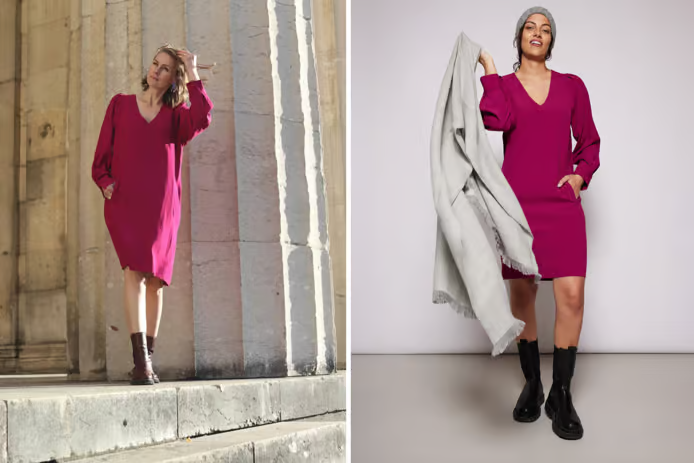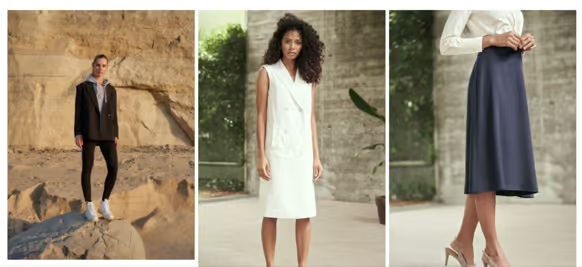What are sustainable brands and how can one find them? How can one bundle like-minded brands that appeal to a common target group? Isabell Conrad asked herself these and other questions after spending much time and energy searching for sustainable designer fashion and slow fashion online. For the business graduate, the matter was clear - draw up a business plan and see whether a marketplace for sustainable fashion would make commercial sense. It did. FashionUnited spoke with Conrad about founding Upconic, an online marketplace for slow fashion, sustainable designer clothing and accessories.

What was your motivation behind setting up a marketplace for sustainable designer fashion for women?
I wasn't actually focussed on founding, the approach was more “what bothers me in life, where do I want to create change?”. I wanted to do something with an impact, even if it was only a small impact. I always liked the dress code in the office, but I realised that I was always buying the same brands - Max Mara, Boss and Strenesse.
Fashion brands are also very harmful in terms of environmental impact. So I started looking for sustainable brands for premium women's fashion and realised that searching online can be a very tedious process. So I asked myself, “why isn't there one place where you can find cool, sustainable fashion?”. And so the idea for Upconic was born.
How did you come up with the name and what does it mean?
I wanted something that was short and memorable, but also international. So I played around with a few word combinations and “upwards” and “iconic” clicked and merged into “Upconic”. I deliberately avoided any reference to recycling or eco.

Who is your target group?
They are young, urban women between 25 and 50 who are looking for a certain lifestyle. I wanted to create a lifestyle marketplace that is sustainable. And where the appreciation for clothing can come back, away from the throwaway culture.
How has the platform been received?
The response is positive; many people say “I have been looking for something like this“.
What brands are currently available?
There's Katharina Funke-Braun with her brand Limo, which stands for “less is more”. She offers high-quality, minimalist and easy-to-combine fashion for women by upcycling discarded materials. Charlotte Piller and Nhu Ha Dao are behind Berlin brand Lotta Ludwigson, which takes a circular approach to its business attire for women. Setery from Munich by Hanna Greis offers a sustainable office wardrobe that is also suitable for other occasions.
L'amour est blue by Thien Huynh from Berlin specialises in sustainable and timeless slow fashion womenswear, while Bogdana Nuss captures the zeitgeist with Iva Rych. Julia Ickert offers fair fashion with her brand Nina Rein and Wote produces minimalist women's and men's fashion made in Italy and Portugal. Suitition, as the name suggests, offers power suits for women.

What are the criteria brands need to fulfil for being included in the marketplace?
All brands must be sustainable and offer timeless women's fashion or accessories. Humane and fair production is essential. There are several approaches to sustainable materials, such as recycled materials (but no polyester), or the items being certified sustainable, such as leather or cashmere from responsible sources. What I also consider sustainable is the use of deadstock.
How do you verify that?
I had long discussions with the founders and did a lot of research on the internet.
I also look at how sustainable the production itself is; is there CO2 offsetting? Is electricity produced in-house? Is there a zero-waste approach? Production in Germany or nearby is also very important - the current labels actually mainly produce in Germany, the EU and one in Ukraine. Charitable initiatives, such as water projects, are desirable, but not a must. Likewise vegan products.
How does the platform work for participating brands?
With low costs on both sides. There is no onboarding fee for the brands, they only pay a commission of 20 percent on sold articles and ship the items themselves. So there are no storage costs for me. Everything is automatic; as I come from the IT sector, I knew how best to connect the Shopify ordering systems. I create the article pages and especially the descriptions for the articles myself so that everything is standardised.
And how does it work for customers?
What is important here is how good the customer journey is. Useful filters are particularly important - for example, for the colour, neckline, sleeve length or the collar shape of a desired item. Existing platforms often don't live up to expectations and needs in this respect. Plastic-free will soon be added as a new criterion at Upconic.
What does the future hold for Upconic?
Definitely bringing more labels on board. Then also expanding the womenswear range - we currently have 230 items, which should be four to five times as many, but of course while maintaining the excellent customer experience. At some point, menswear could also be added. It is also important to build an ecosystem of like-minded brands and solve common problems together. This involves a lot of dialogue with the labels. Then, in time, the expansion of the range to Europe.


You must be logged in to post a comment.